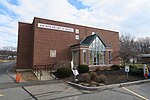Reuben Lamprey Homestead
Colonial architecture in the United StatesHampton, New HampshireHouses in Rockingham County, New HampshireHouses on the National Register of Historic Places in New HampshireNational Register of Historic Places in Rockingham County, New Hampshire

The Reuben Lamprey Homestead is a historic house at 416 Winnacunnet Road in Hampton, New Hampshire. Built in the 1770s, the property is the best-preserved colonial-era farm complex in the town. It was listed on the National Register of Historic Places in 1982.
Excerpt from the Wikipedia article Reuben Lamprey Homestead (License: CC BY-SA 3.0, Authors, Images).Reuben Lamprey Homestead
Winnacunnet Road,
Geographical coordinates (GPS) Address Nearby Places Show on map
Geographical coordinates (GPS)
| Latitude | Longitude |
|---|---|
| N 42.930833333333 ° | E -70.812777777778 ° |
Address
Winnacunnet Road 410
03842
New Hampshire, United States
Open on Google Maps









